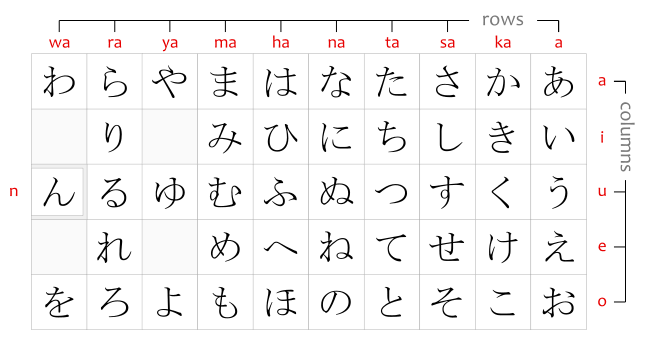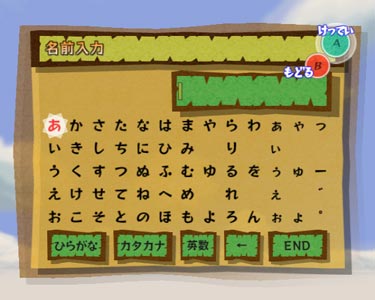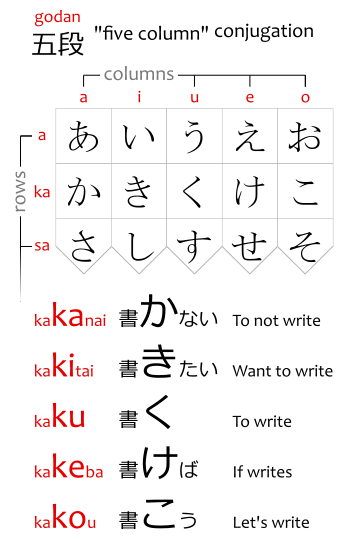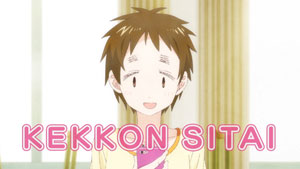The term is also romanized gojūon, with a macron on the long vowel.
Table
The gojūon as a table, or chart, is also called gojūonzu 五十音図, "fifty sounds diagram." There are some variants, but it basically looks like this:
Source: japanesewithanime.com (CC BY-SA 4.0)
The table is headed by the five columns a-i-u-e-o あいうえお, in that order. No, it's not a-e-i-o-u, like in the Latin alphabet, it's a-i-u-e-o, which sounds all wrong when you hear it at first, but it's actually how it is in Japanese.
The ten rows are the consonant-less row, plus consonants k, s, t, n, h, m, y, r, and w. Once again, the order is all weird, but you get used to it. (or you don't, because it's not like it's that important, anyways.)
The gojūon layout predates modern Japanese, and modern Japanese pronunciation. Some characters that existed in old Japanese, like wi ゐ and we ゑ, no longer exist in modern Japanese, while others were added, like the syllable final n ん.
Consequently, the fifty sounds aren't even really fifty, plus n ん doesn't really fit anywhere in the table and sticks out like a sore thumb.
Lastly, the fifty sounds only includes the basic kana, there are other sounds in the Japanese language beyond them.
For example, ga が is a ka か with a dakuten 濁点, the ka か is part of the gojūon, but ga が is not. The diphthongs like kya きゃ are also not part of the gojūon, and are called youon 拗音 instead.
An example of a variant:
Game: The Legend of Zelda: The Wind Waker, Zeruda no Densetsu Kaze no Takuto ゼルダの伝説 風のタクト
- The "name input" screen, namae-nyuuryoku 名前入力, of many games use a gojūon layout.
- Observe how it also includes essential characters that aren't part of the gojūon, like the small kana, the small tsu っ, the prolonged sound mark ー, and the dakuten ゛and handakuten ゜.
Rows and Columns
In Japanese, the "columns" are called dan 段, and the "rows" are called gyou 行.The a-dan ア段, for example, refers to the "a column," going through a-ka-sa-ta-na-ha-ma-ya-ra-wa あかさたなはまやらわ.
The ka-gyou カ行 refers to the "ka row," going through ka-ki-ku-ke-ko かきくけこ.
Note that the kana represent whole syllables, and there's no way to represent the consonant alone in native Japanese. Hence why the ka-gyou is referred by the ka か syllable, not by the "k" consonant. There's no way to write just the "k" in native Japanese.
Also note that Japanese is traditionally written right-to-left, so the tables start at the right (not at the top) and expand to the left (not to the bottom). Consequently, it ends up looking like the rows are the columns and the columns are the rows, but they aren't. It's just kind of flipped.
Source: japanesewithanime.com (CC BY-SA 4.0)
Verbs
Two major groups of Japanese verbs, the ichidan verbs and godan verbs, have their names originating in the gojūon table.In the conjugation of ichidan 一段, "one column," verbs, the stem always end in the same vowel (column), in other words, it always end in the same one column.
- tabe-nai
食べない
To not eat. - tabe-tai
食べたい
Want to eat. - tabe-ru
食べる
To eat. - tabe-reba
食べれば
If eats. - tabe-you
食べよう
Let's eat.
In godan 五段, "five column," verbs, the ending of the stem ranges across all five vowels (columns), depending on the form it's conjugated to. For example, a godan verb ending in ku く ranges across ka-ki-ku-ke-ko かきくけこ.
- kaka-nai
書かない
To not write. - kaki-tai
書きたい
Want to write. - kaku
書く
To write. - kake-ba
書けば
If writes. - kako-u
書こう
Let's write.
Source: japanesewithanime.com (CC BY-SA 4.0)
The godan verbs that end in ~u, like kau 買う, "to buy," are said to be wa-a-gyou ワア行 verbs, "wa-a row," because the negative form would be kawanai 買わない, "to not buy," for example, which isn't in the a-row (a-i-u-e-o), it's in the wa-row (wa-wo).
Romaji
Some romanization systems are strictly based on the gojūon table, while others are not.The Hepburn system is based on the pronunciation of Japanese. It romanizes Japanese approximately with English consonants and Italian vowels, so it may not make much sense if you only speak English. The romaji of some rows end up looking like this:
- sa-shi-su-se-so
さしすせそ - ta-chi-tsu-te-to
たちつてと - ha-hi-fu-he-ho
はひふへほ.
As you can see, it's all over the place, and makes you question "why is this even like this?"
This happens because the Hepburn system was created to teach Japanese to foreigners, who don't know how to speak Japanese. It's the one used in names of manga and anime in English websites, like Kimetsu no Yaiba.
By contrast, the Nihon-Shiki system is a standard used by Japanese people, who already know how Japanese is pronounced, and probably have no idea how English or Italian is pronounced. so the Hepburn system doesn't benefit them. The rows in Nihon-Shiki are romanized like this:
- sa-si-su-se-so
さしすせそ - ta-ti-tu-te-to
たちつてと - ha-hi-hu-he-ho
はひふへほ
I don't know Italian, but in Portuguese "tu" sounds like "too" in English, and neither sounds like つ in Japanese. This system doesn't care about how stuff is pronounced. It's just a quick easy to convert Japanese characters to Latin characters, based on the gojūon table.
This would be used, for example, in URLs of websites, like like syosetu.com, which means shousetsu 小説, "novel."
Anime: Asobi Asobase あそびあそばせ (Episode 3)
- kekkon shitai
結婚したい
Want to marry. - In romaji that appears in an anime created in Japan, for a Japanese audience, uttered by a Japanese fictional character, the shi し is romanized si し.
Sorting
The gojūon-jun 五十音順, "fifty sounds order," is a way to sort words based on the gojūon table. It's the Japanese variant of sorting things alphabetically.- あいうえお
- かがきぎくぐけげこご
- さざしじすずせぜそぞ
- ただちぢつっづてでとど
- なにぬねの
- はばぱひびぴふぶぷへべぺほぼぽ
- まみむめも
- やゃゆゅよょ
- らりるれろ
- わを
- ん
The order starts with a-i-u-e-o あいうえお, then ka-ki-ku-ke-ko かきくけこ, and so on.
The n ん is the kana with least priority, as if it were the last letter of the alphabet, Z. This means that kawa かわ, "river," comes before kan かん, "feeling," in the gojūon ordering.
The syllables without dakuten, like ha-hi-fu-he-ho はひふへほ, come before the ones with dakuten, ba-bi-bu-be-bo ばびぶべぼ, which, in turn, come before the ones with handakuten, pa-pi-pu-pe-po ぱぴぷぺぽ.
In other words, it goes: ha-ba-pa-hi-bi-pi-fu-bu-pu はばぱひびぴふぶぷ, and so on.
The small kana are ordered just like their normal-sized variants. This means that ki-ya きや comes before the diphthong kya きゃ, which comes before ki-yu きゆ.
The small tsu っ obeys this same rule, but note that in romaji it's represented by duplicating the consonant that comes after it, so the ordering appears all wrong in romaji. Observe:
- totsuzen
とつぜん
Suddenly. - toppa
とっぱ
To break through. - totemo
とても
Very.
Above the small tsu っ in toppa とっぱ is romanized as a p, since what comes after is pa ぱ. That's irrelevant as far as the gojūon ordering is concerned—the small tsu っ still comes before te て, because the normal tsu つ does come before te て in the row ta-chi-tsu-te-to たちつてと.





Hapburn is definitely not based on Italian. In fact it's much farther from Italian than from English or French
ReplyDeleteFor example, 'chi' is actually pronounced as 'ki' in Italian. 'Shi'... they don't have such strange digraph, they use 'sci' instead. So, how do they pronounce 'chi' then? 'cci' desu. And they don't use 'k' much, since it's not truly native for them. etc etc
Hapburn is totally english based. You csn see it, for instance, from 'sh' which is quite typical for english while other european langusge usually use different ways to represent this sound (sch, ch, x etc)
You're right. I checked it again, and it seems that only the vowels are Italian, but the consonants are English. Thanks.
Delete